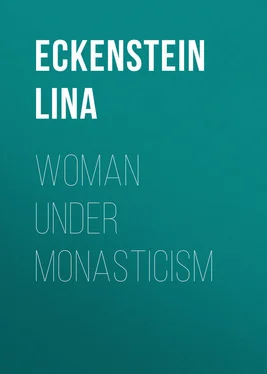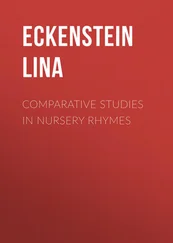Lina Eckenstein - Woman under Monasticism
Здесь есть возможность читать онлайн «Lina Eckenstein - Woman under Monasticism» — ознакомительный отрывок электронной книги совершенно бесплатно, а после прочтения отрывка купить полную версию. В некоторых случаях можно слушать аудио, скачать через торрент в формате fb2 и присутствует краткое содержание. Жанр: История, foreign_antique, foreign_prose, на английском языке. Описание произведения, (предисловие) а так же отзывы посетителей доступны на портале библиотеки ЛибКат.
- Название:Woman under Monasticism
- Автор:
- Жанр:
- Год:неизвестен
- ISBN:нет данных
- Рейтинг книги:4 / 5. Голосов: 1
-
Избранное:Добавить в избранное
- Отзывы:
-
Ваша оценка:
- 80
- 1
- 2
- 3
- 4
- 5
Woman under Monasticism: краткое содержание, описание и аннотация
Предлагаем к чтению аннотацию, описание, краткое содержание или предисловие (зависит от того, что написал сам автор книги «Woman under Monasticism»). Если вы не нашли необходимую информацию о книге — напишите в комментариях, мы постараемся отыскать её.
Woman under Monasticism — читать онлайн ознакомительный отрывок
Ниже представлен текст книги, разбитый по страницам. Система сохранения места последней прочитанной страницы, позволяет с удобством читать онлайн бесплатно книгу «Woman under Monasticism», без необходимости каждый раз заново искать на чём Вы остановились. Поставьте закладку, и сможете в любой момент перейти на страницу, на которой закончили чтение.
Интервал:
Закладка:
We will show later on how the ideal conception prevailed, and how the heathen mother-goddess often assumed the garb of a Christian woman-saint, and as a Christian woman-saint was left to exist unmolested. Not so the heathen priestess and prophetess. From the first introduction of Christianity the holding of sacerdotal powers by women was resented both within and without the Church, and opprobrium was cast on the women who claimed to mediate between the human and the divine.
At the time of the advent of Christianity the Gannas and Veledas of the Roman period are still a living reality; they are the ‘wise women’ who every now and then leave their retreat and appear on the stage of history. A prophetess in gorgeous apparel makes her entry into Verdun in the year 547, drawing crowds about her and foretelling the future. She is in no way intimidated by the exorcisms of prelates, and presently leaves to betake herself to the court of the Frankish queen Fredegund. Again in 577 we find the Frankish king Guntchramm in consultation with a woman soothsayer, and other cases of the kind are on record 3 3 Gregorius Tur., Hist. Eccles. 5, ch. 14, 16, 19.
.
In the ninth century the Church more effectually exercised her influence in the case of the woman Thiota, who coming from Switzerland inflamed the minds of the folk in Mainz; for she was accused of profanity and publicly scourged 4 4 Grimm, J., Deutsche Mythologie , 1875, p. 78.
. But for all the attacks of the Church, the folk persisted in clinging to its priestesses and in believing them gifted with special powers. Grimm shows how the Christian accusers of soothsaying women made them into odious witches 5 5 Ibid. p. 881 ff.
; Wuttke and Weinhold, both well-known students of folk-lore, consider that witches were originally heathen priestesses 6 6 Wuttke, Deutscher Volksaberglaube , 1869, p. 141; Weinhold, K., Deutsche Frauen , 1882, vol. 1, p. 73.
. The intrinsic meaning of the word hexe , the German designation for witch, points to some one who originally belonged to a group living in a particular manner, but whose practices made her obnoxious to those who had apprehended the higher moral standard of a later social period. But the Church failed to stamp even the witch as wholly despicable; for in popular estimation she always retained some of the attributes of the priestess, the wise woman, the bona domina , the ‘white witch’ of tradition; so that the doctrine that the soothsaying woman is necessarily the associate of evil was never altogether accepted. Even now-a-days incidents happen occasionally in remote districts which show how the people still readily seek the help of women in matters of wisdom, of leechcraft, and of prescience. It was only under the influence of a scare that people, who were accustomed to consult the wise woman in good faith, could be brought to abhor her as a witch. It was only during the later Middle Ages that the undisputed and indisputable connection of some ‘wise women’ with licentious customs gave their traducers a weapon of which they were not slow to avail themselves, and which enabled them to rouse fanaticism of the worst kind against these women.
The practices and popularity of witchcraft were in truth the latest survivals of the mother-age. The woman, who devised love-charms and brewed manifold remedies for impotence and for allaying the pangs of childbirth, who pretended to control the weather and claimed the power to turn the milk of a whole village blue, carried on traditions of a very primitive period. And her powers, as we shall see, always had a close parallel in those attributed to women-saints. For example St Gertrud of Nivelles has left a highly prized relic to womankind in the form of a cloak which is still hung about those who are desirous of becoming mothers 7 7 Rochholz, E. L., Drei Gaugöttinnen , 1870, p. 191.
; and the hair of a saint, Mechthild, is still hung outside the church at Töss in Switzerland to avert the thunderstorm 8 8 Menzel, Christliche Symbolik , 1854, article ‘Haar.’
; and again St Gunthild of Biberbach and others are still appealed to that they may avert the cattle plague 9 9 A. SS. Boll. , St Gunthildis, Sept. 12.
. What difference, it may be asked, is there between the powers attributed to these saints and the powers with which witches are usually credited? They are the obverse and reverse of woman’s connection with the supernatural, which in the one case is interpreted by the sober mind of reverence, and in the other is dreaded under the perturbing influence of a fear encouraged, if not originated, by Christian fanatics.
In the Christian Church the profession of the nun was accepted as holy, but an impassable gulf separated her from the priestess. During early Christian times we come across the injunction that women shall not serve at the altar 10 10 Bouquet, Recueil Hist. , vol. 5, p. 690. Capitulare incerti anni, nr 6, ‘ut mulieres ad altare non ingrediantur.’
, and that lady abbesses shall not take upon themselves religious duties reserved to men by the Church. When we think of women gathered together in a religious establishment and dependent on the priest outside for the performing of divine worship, their desire to manage things for themselves does not appear unnatural, encouraged as it would be by traditions of sacerdotal rights belonging to them in the past. And it is worthy of notice that as late as the 13th century, Brother Berthold, an influential preacher of south Germany, speaks ardently against women who would officiate at divine service and urges the mischief that may result from such a course.
Turning to the question of how far these obvious survivals from a heathen age are determined by time and place, we find broad lines of difference between the heathen survivals of the various branches of the German race, and considerable diversity in the character of their early Christianity and their early women-saints. This diversity is attributable to the fact that the heathen beliefs of these various peoples were not the same at the time of their first contact with Christianity, and that they did not accept it under like circumstances.
For while those branches of the race who moved in the vanguard of the great migration, the Vandals, the Burgundians and the Goths, readily embraced Christianity, it was Christianity in its Arian form. Arianism, which elsewhere had been branded as heresy and well-nigh stamped out, suddenly revived among the Germans; all the branches of the race who came into direct contact with peoples of civilized Latinity readily embraced it. Now one of the distinguishing features of Arian belief was its hatred of monasticism 11 11 Montalembert, Monks of the West , 1, p. 359.
. The Arian convert hunted the monk from his seclusion and thrust him back to the duties of civic life. It is not then among Germans who adopted Arian Christianity that the beginnings of convent life must be sought. Indeed as Germans these peoples soon passed away from the theatre of history; they intermarried and fell in with the habits of the people among whom they settled, and forfeited their German language and their German traditions.
It was otherwise with the Franks who entered Gaul at the close of the fourth century, and with the Anglo-Saxons who took possession of Britain. The essentially warlike character of these peoples was marked by their worship of deities such as Wodan, a worship before which the earlier worship of mother-divinities was giving way. Women had already been brought into subjection, but they had a latent desire for independence, and among the Franks and Anglo-Saxons women of the newly converted race eagerly snatched at the possibilities opened out by convent life, and in their ranks history chronicles some of the earliest and most remarkable developments of monasticism. But the Franks and the Anglo-Saxons, in leaving behind the land of their origin, had left behind those hallowed sites on which primitive worship so essentially depends. It is in vain that we seek among them for a direct connection between heathen mother-divinity and Christian woman-saint; their mother-divinities did not live on in connection with the Church. It is true that the inclination to hold women in reverence remained, and found expression in the readiness with which they revered women as saints. The women-saints of the Anglo-Saxons and the Franks are numerous, and are nearly all known to have been interested in convent foundations. But the legends, which in course of time have crystallised round them, and the miracles attributed to them, though containing certain elements of heathen folk-tradition, are colourless and pale compared with the traditions which have been preserved by saint legend abroad. It is in Germany proper, where the same race has been in possession of the same sites for countless generations, that the primitive character of heathen traditions is most pronounced and has most directly determined and influenced the cult and the legends of women-saints.
Читать дальшеИнтервал:
Закладка:
Похожие книги на «Woman under Monasticism»
Представляем Вашему вниманию похожие книги на «Woman under Monasticism» списком для выбора. Мы отобрали схожую по названию и смыслу литературу в надежде предоставить читателям больше вариантов отыскать новые, интересные, ещё непрочитанные произведения.
Обсуждение, отзывы о книге «Woman under Monasticism» и просто собственные мнения читателей. Оставьте ваши комментарии, напишите, что Вы думаете о произведении, его смысле или главных героях. Укажите что конкретно понравилось, а что нет, и почему Вы так считаете.












